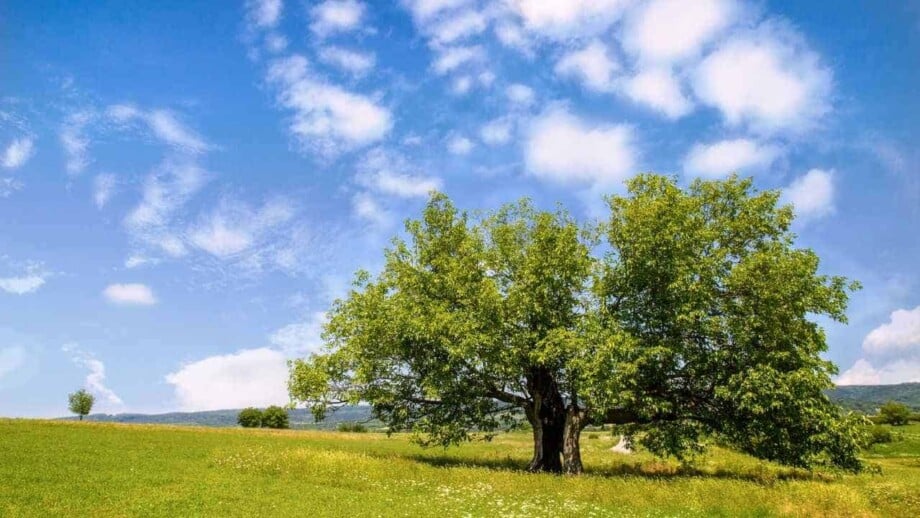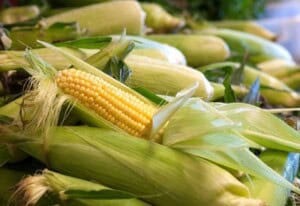Mulberry trees are often overlooked in the realm of fruit-bearing trees, but their delectable mulberry fruit is a hidden gem that shouldn’t be ignored. These trees, which can reach up to 50 feet in height, are known for their glossy, dark green leaves and small, clustered fruit ranging from deep purple to reddish-black.
Mulberry fruit is not only a tasty treat for humans and wildlife alike, but it is also packed with natural nutrients. From their historical significance to modern-day uses, mulberry trees have much to offer.
One of their most redeeming qualities is their minimal care requirements. But before we dive into the care of mulberry trees, let’s first talk about what makes this tree unique and the different types.

Botanical Name: Morus spp.
Common Name: Mulberry tree, white mulberry, red mulberry
Family: Moraceae
Plant Type: Deciduous tree
Hardiness Zones: 4-8 USDA
Sun Exposure: Full, partial
Soil Type: Rich, moist but well-drained
Soil pH: Mildly acidic to neutral
Height: 30–60 ft. tall
Bloom Time: Spring
Flower Colors: Yellowish-green
Native Area: North America, China
What’s a Mulberry Tree?
Mulberry is a medium-sized tree that produces small tasty fruits in the summer.
Two species are commonly found in the northern U.S.: red mulberry and white mulberry.
Both species possess dark green leaves with serrated edges and have berries resembling blackberries.
The white mulberry tree, also known as Morus alba, has gained a reputation as a hybridizer and aggressive spreader, often resulting in stained sidewalks from their abundant fruit production. This species and its hybrid forms are likely culprits of these colorful and messy streetscapes. Despite these concerns, mulberry trees can make an excellent addition to any landscape when correctly cared for.
Early spring is the optimal time for planting as these trees proliferate quickly and require ample time to establish their root system. With proper maintenance, mulberry trees can provide a bountiful harvest of their delicious fruit.
Mulberry Fruit
Mulberry fruits have a unique flavor profile that is often compared to a mix of grapefruit, loganberries, and blackberries. Not only are they delicious, but they are also the juiciest members of the Moraceae family. Mulberries can be enjoyed in fresh and dried forms, making them a versatile and convenient addition to any diet.
In addition to their delicious taste, mulberry fruits are packed with various health-enhancing nutrients.
They are a rich source of antioxidants, lipids, dietary fiber, and protein, making them an excellent addition to any balanced diet. Mulberries are exceptionally high in vitamin C, a key nutrient that supports immune function and collagen production. They are also a good source of riboflavin, resveratrol, zeaxanthin, iron, potassium, magnesium, manganese, and other essential minerals that promote overall health and wellness.

Mulberry Health Benefits
Mulberries offer lots of health benefits. Eating this fruit can improve overall health thanks to its nutrients.
- Digestion: Mulberry fruits contain dietary fiber, which facilitates bowel movement and helps prevent bloating, constipation, and stomach cramps
- Immune system: Besides being rich in vitamin C, mulberry fruits contain alkaloids that help with macrophage activation.
- Blood sugar levels: White mulberries contain a substance similar to one used to treat type 2 diabetes.
- Cholesterol level: Mulberry tree and mulberry extract helps regulate cholesterol levels
- Blood circulation: mulberries are rich in antioxidants which help enhance the blood vessels functioning.
- Brain health: These berries are rich in calcium and other minerals that help keep the brain healthy.
- Eyesight: Rich in zeaxanthin, mulberries help to reduce oxidative stress in the eyes’ cells and protect the retina.
- Lungs health: The mulberry’s bark contains antibacterial properties that inhibit influenza and other viruses that produce lung infections.
- Liver health: Mulberries are rich in iron, which helps strengthen the lives and nourish and purify the blood.
Types of Mulberry Trees
Besides the two mulberries that can be found in North America, there are three additional species to discuss:
- White Mulberry tree (Morus Alba): This is the most common mulberry tree in North America. This Chinese native tree can be easily distinguished from other mulberries thanks to its blackberry-shaped fruit.
- Red Mulberry Tree (Morus Rubra): This mulberry tree has rough leaves that are twice as big as the Morus alba and have a coarse, hairy underside. Their mulberry fruit starts green, and the trunk is purplish red when ripe. Red mulberries grow in the wild around the U.S. and eastern Canada.
- Texas Mulberry Tree (Morus centifolia): This tree is native to the southwest and is more shrub-like. It can measure up to 25 feet in height and has red, purple, or black fruits, which draw birds and wildlife to your landscape.
- Korean Mulberry Tree(Morus australis): This small tree reaches only 20-30 feet at maturity. It has light green foliage that is slightly glossed, and its fruit color ranges from white to deep purple and red. This mulberry tree is not a common landscape tree in the U.S.
- Black mulberry tree (Morus nigra): This tree measures 40 feet tall on average, and it features dark (almost black) berries that are large when ripe. This mulberry tree is native to Asia and is not commonly found in North America.

Mulberry Tree Care
While mulberry trees are generally easy to cultivate, they may not be suitable for all gardens. For those who desire a low-maintenance option, fruitless cultivars such as “Chapparal” and “Kingan” may be the ideal choice.
It’s important to note that mulberry trees have fast-growing and extensive root systems that can cause damage to structures such as driveways, garages, foundations, utilities, and septic systems. Therefore, planting the tree away from these essential features is best to avoid potential risks.
Additionally, when selecting a planting location, it’s essential to consider the tree’s mature height and spread. Choosing an area where the tree can grow freely without excessive pruning is optimal, as this reduces stress on the tree and encourages it to produce an abundance of delicious fruit.
When taking these factors into account, mulberry trees can be a valuable addition to any garden or orchard.
Lighting Requirements
Mulberry trees can thrive in both partial shade and full sun conditions, though, as with many trees that grow fruits, more light = more fruit.
These trees require ample sunlight to thrive, making them a great addition to sunny, well-lit areas. They typically need at least 6-8 hours of direct sunlight daily to produce a healthy and abundant harvest. While they can tolerate some shade, insufficient light can lead to poor fruit production and overall growth.
It’s important to note that the intensity and duration of sunlight can vary depending on the specific cultivar of your mulberry tree. Some varieties, such as the white mulberry, can tolerate partial shade, while others, such as the black mulberry, require full sun to produce their sweet and flavorful fruit. Additionally, young mulberry trees may require a bit of shade during their first year of growth to avoid excessive heat and sun exposure.
Overall, providing a sunny and well-lit location for your mulberry tree is key to ensuring its growth and productivity.
Regular pruning and maintenance can also help to maximize its exposure to sunlight and promote healthy growth.
Watering Requirements
Mulberry trees are somewhat drought-resistant and have moderate watering needs. While they can tolerate some drought, avoiding excessive dryness is essential, which can lead to stunted growth, wilting, and poor fruit production.
The frequency and amount of watering required will depend on various factors, such as the age of the tree, soil type, and climate conditions. In general, newly planted mulberry trees should be watered deeply once or twice a week during the first growing season to help establish their root system. Mature trees require less frequent watering but may benefit from a deep watering every 2-3 weeks during the growing season.
It’s important to note that overwatering can also be detrimental to mulberry trees, as it can lead to root rot and other fungal diseases. To avoid this, ensure proper drainage and avoid watering during periods of heavy rain or excessive moisture.
Consistent and moderate watering is vital to maintaining a healthy and productive mulberry tree. Monitoring soil moisture levels and adjusting watering frequency can help ensure optimal growth and fruit production.
Humidity Requirements
Mulberry trees generally tolerate a wide range of humidity levels and can adapt to dry and humid climates. However, they prefer moderate humidity levels, which are neither too dry nor damp.
In regions with high humidity, ensuring good air circulation around the tree is crucial to prevent fungal diseases such as powdery mildew and leaf spot. This can be achieved by planting your tree in an open, well-ventilated area and avoiding crowded planting conditions.
Mulberry trees may benefit from occasional misting or spraying in drier climates to increase humidity levels and prevent leaf wilting. Also, maintaining proper soil moisture levels through regular watering can help mitigate the dry air’s effects.
Overall, while mulberry trees can adapt to various humidity levels, ensuring adequate air circulation and soil moisture is critical to promoting optimal growth and fruit production.
Temperature Requirements
Mulberry trees are generally hardy and can tolerate a range of temperatures. However, they have specific temperature requirements for optimal growth and fruit production.
Mulberry trees prefer a warm and temperate climate, with a preferred temperature range of 70-85°F (21-29°C) during the day and 45-65°F (7-18°C) at night. They can tolerate temperatures as low as 20°F (-7°C) in winter but may experience damage or dieback if exposed to prolonged freezing temperatures.
In areas with hot summers, it’s crucial to ensure that the tree has adequate shade and moisture to prevent stress and sunburn. Mulberry trees also benefit from winter dormancy, which helps promote healthy growth and fruit production in the following season.
By ensuring that your mulberry tree is planted in a suitable climate and provided with adequate protection from extreme temperatures, you can help ensure healthy growth and abundant fruit production.
Soil Requirements
Mulberry trees prefer well-draining soil that is rich in organic matter and nutrients. They can grow in a range of soil types, including sandy, loamy, and clay soils, but they do best in soils that are slightly acidic to neutral, with a pH range of 6.0 to 7.0.
Before planting a mulberry tree, it’s important to ensure the soil is adequately prepared by removing any weeds or debris and amending it with organic matter such as compost or well-rotted manure. This will help to improve soil structure, increase nutrient availability, and promote healthy root growth.
Mulberry trees also have a deep root system and require ample space for root development. It’s important to avoid planting them in compacted or poorly drained soil, as this can lead to root rot and other issues.
Overall, providing well-draining, nutrient-rich soil and ensuring proper soil preparation before planting can help ensure healthy growth and fruit production in your mulberry tree. Regular soil testing and amendment can also help to maintain optimal soil conditions over time.
Fertilizer Requirements
Mulberry trees require regular fertilization to support healthy growth and fruit production. They generally benefit from a balanced fertilizer that provides equal amounts of nitrogen, phosphorus, and potassium.
It’s best to fertilize mulberry trees in early spring, just as new growth begins, and again in early summer after the fruit has set. Slow-release fertilizers are a good choice for mulberry trees, as they provide a steady supply of nutrients over time.
In addition to NPK fertilizers, mulberry trees can also benefit from organic fertilizers such as compost, manure, or bone meal. These can be applied as a top dressing or worked into the soil around the base of the tree.
When fertilizing mulberry trees, avoiding over-fertilization is vital, which can lead to excessive vegetative growth and reduced fruit production. Always follow the manufacturer’s instructions when applying fertilizer, and be sure to water the tree thoroughly after application to prevent burning.
Feed your mulberry tree once in late winter with a balanced 10-10-10 mix and measure 1 pound of fertilizer for every inch of the trunk’s diameter.
Overall, by providing regular fertilization with balanced NPK fertilizers and organic amendments, you can help ensure healthy growth and abundant fruit production in your mulberry tree.
Pruning Requirements
Mulberry trees require minimal pruning; in fact, excessive pruning can cause stress and reduce fruit production.
The best time to prune a mulberry tree is in late winter or early spring while the tree is still dormant. You can remove dead, damaged, or diseased branches during this time.
It’s also a good time to shape the tree and remove any suckers or water sprouts that may have emerged from the tree’s base. Avoid pruning too much from the top of the tree, as this can reduce fruit production.
Overall, by pruning selectively and minimally, you can help maintain the health and productivity of your mulberry tree.

Mulberry Tree Propagation
Mulberries are easily propagated by rooting semi-hardwood branch cuttings. The best time to do this is during late spring and early summer. Here’s how to propagate mulberry trees
- As new growth starts, cut 6-8 inch long segments of ½ diameter branches using sharp and clean pruners – ensure that the branches are relatively new but not soft and green.
- Dip the cuttings’ bottom into rooting hormone, and plant the ends in pots filled with seed starter mix or commercial potting soil.
- Water the pots thoroughly, then place them inside 1-gallon clear plastic bags sealed with rubber bands.
- Place the pots in a shaded area until they root.
- Ensure that your soil remains moist.
- After a month, when the cuttings have rooted, remove the plastic bags and grow them in pots until fall, when they can be replanted in the garden.

Mulberry Tree Common Problems
Mulberry trees, in general, are problem free. Although they’re not immune, here are some common issues you may encounter when growing mulberries and how to fix them.
Pests
Mulberries may contend with various pests such as mealybugs, whitefly, and scale.
The good news is that these pests do not cause much damage to mature mulberries, as they’re tough enough to withstand it, which is good cause treating large trees is not easy. If you notice any sign of infestation on younger saplings, you can use neem oil or different horticultural oils to treat it.
Not blooming
Mulberry trees are often not prized for their blooms as they are not particularly showy, and their resulting fruits can be messy and difficult to deal with.
However, if you want to encourage blooming and fruit production from your tree, it’s important to ensure its basic needs are met. This includes providing adequate water, fertilization, and sunlight and properly pruning the tree to maintain its health and shape. By taking care of your mulberry tree, you can encourage it to bloom and produce fruit that can be enjoyed in a variety of delicious ways.
Stains From Fruit
This tree’s fertile and fruiting varieties are often considered a nuisance since its fallen fruit will stain pavement and even cars. To avoid this, plant a sterile cultivar that does not produce fruit.
If you want a mulberry tree-producing fruit, try positioning it in a patio area where the fruit won’t create a mess.
Mulberry Tree Toxicity
Besides the ripe berries, all parts of any mulberry tree can be toxic to humans and animals as it contains latex in its milky sap. If you consume a fruit that is not ripe yet, you may present an upset stomach, nervous system stimulation, or (in severe cases) hallucinations.
Other Tree Guides from Planet Natural:
20 Most Popular Types of Palm Trees for Homeowners
How to Plant, Grow, and Care for Mimosa Tree – Full Guide – 2023











